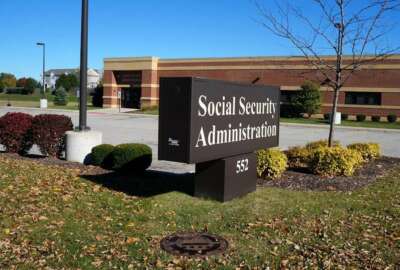 First Look
First Look SSA looking to recall more field office employees to handle ‘dire-need’ situations’
Much of the agency is still teleworking, but the Social Security Administration told field office employees this week it would begin to recall some to help with the...
The Social Security Administration is planning to ask more employees, first on a volunteer basis, to return to the agency’s field offices.
Managers have been coming into the field offices since the beginning days of the pandemic to handle the mail and process “dire-need cases.” Some SSA employees have joined them at the request of their managers, but the American Federation of Government Employees union, which represents workers at the agency’s field offices, didn’t consider those recalls to be large-scale.
Now, the agency will solicit more volunteers to return to their field offices, Sherry Jackson, a vice president with AFGE Council 220, told Federal News Network.
Offices that don’t have enough volunteers will begin recalling employees to work in person on a rotational basis. Employees who have been chosen to return will receive a recall letter from their area managers and two weeks notice before they’re expected in the office, Jackson said.
It’s up to each manager to determine how many employees should return to each field office, said Jackson, who sat in on several meetings this week about SSA’s plans.
“We continue to maximize telework for services we can provide online or over the phone and only bring the fewest number of employees in when absolutely necessary to handle critical work —like dire need appointments, opening mail, work needed to support our remote workers and returning documents to the public — that we can only do in the office,” Mark Hinkle, an SSA spokesman, said in an email to Federal News Network. “Offices must be able to meet other criteria, like the ability to socially distance everyone in the office.”
Jackson said the agency didn’t mention when it would send employees recall letters or how many it would ask to return to SSA field offices.
“We don’t know who they’re calling back, how they’re making those decisions or how the rotation is set up,” she said.
Depending on the workload, employees may work from the office between one and five days a week, Jackson said.
Most field office employees have told their managers or responded to SSA polls about their individual needs at home. The agency told the union it wouldn’t recall employees who are considered high risk for coronavirus or those who have dependent care responsibilities, Jackson said.
Employees will continue most of their interactions with the public remotely, as SSA field and local offices are still operating on an appointment-only basis. According to the agency’s “reposturing plan,” SSA said telework and appointment-only operations may continue “for an extended time.”
Employees said the plan, which SSA released to the workforce two weeks ago, was the first agency-wide document describing its re-entry plans during the pandemic.
SSA said it would instead focus on improving its business processes and IT systems to support remote customer service and make workloads portable. The agency, for example, announced plans on Thursday to begin conducting hearings by video this fall.
“The COVID-19 pandemic has highlighted the importance of finding new ways to serve the public,” SSA Commissioner Andrew Saul said in a statement. “To continue to ensure all participants’ safety, we expect online video hearings and telephone hearings will be the only two hearing options for the foreseeable future.”
But AFGE is concerned about the conditions for employees once they return to their offices, even for a short period of time, and the union has doubts. Before the pandemic, members of the public often crowded the lobbies and employees sat in closely-packed cubicles at SSA field offices.
“There is not six inches, let alone six feet,” Jackson said of the offices.
Members of the public and employees are required to wear a face covering in the office, which the agency may provide depending on local supply, Jackson said.
Guards will be responsible for crowd control — and for policing the mask mandate with members of the public.
“We don’t know what the mask inventory is like in the offices,” Jackson said. “We don’t know what the hand sanitizer situation is in the offices. We don’t know if there is enough soap in the offices so people can wash their hands.”
Hinkle said the agency will have hand sanitizer and cleaning supplies available. Employees will also be subject to health screening questions.
The agency is planning to install “sneeze guards” between employees and members of the public, but the union said it’s looking for more reassurances that SSA is taking other cleaning and health precautions to keep the workforce and public safe.
“We have face coverings available for visitors who do not have their own,” Hinkle said. “We have placed signage in the offices about the steps to minimize risks, our face-covering policy, and the health screening questions.”
Federal employees from other agencies have also expressed concerns about their organization’s reopening plans. Employees at the Agriculture Department’s Food and Nutrition Service and Environmental Protection Agency have been especially vocal.
Those agencies, however, started sharing written re-entry plans with their employees back in May. SSA has been relatively quiet about its re-entry plans for the last several months, which unions have found frustrating.
AFGE accused SSA earlier this summer of withholding information from the union about the agency’s reopening plans. Both the union and agency have been at odds with each other since at least last fall, when SSA eliminated a telework program for operations employees and made additional changes for other populations within the workforce.
But the union said SSA has been light on details, and it’s looking for more out of the agency’s re-entry plans.
“People have been asking for six months — employees, the union, the public — how are you going to keep us safe?” Jackson said. “This is all we have? I don’t think it’s reasonable. There’s too much at stake to be this nonchalant.”
Copyright © 2025 Federal News Network. All rights reserved. This website is not intended for users located within the European Economic Area.
Nicole Ogrysko is a reporter for Federal News Network focusing on the federal workforce and federal pay and benefits.
Follow @nogryskoWFED




